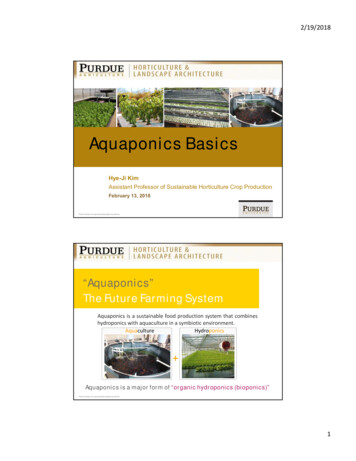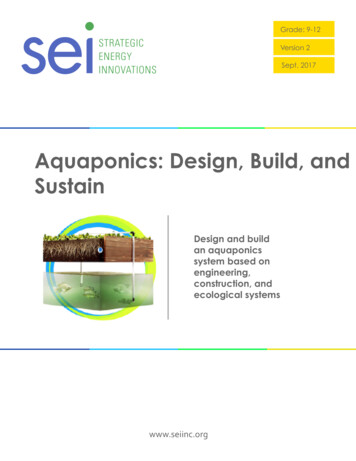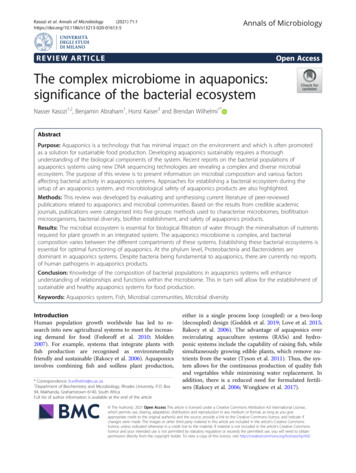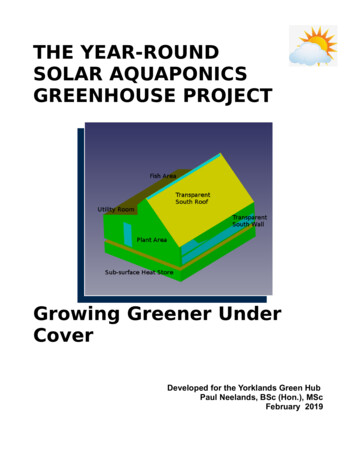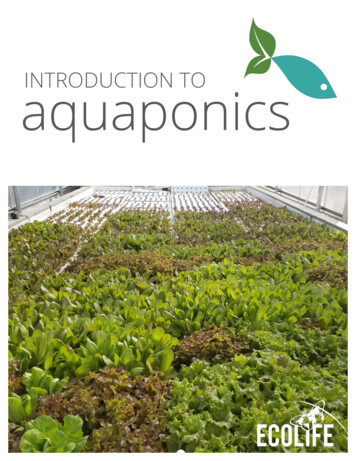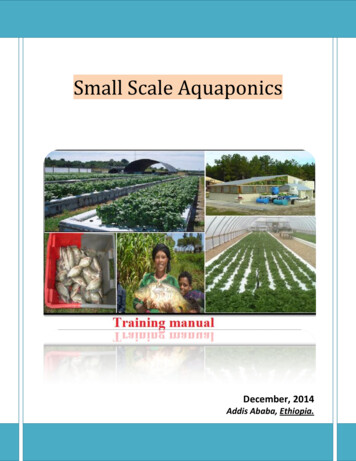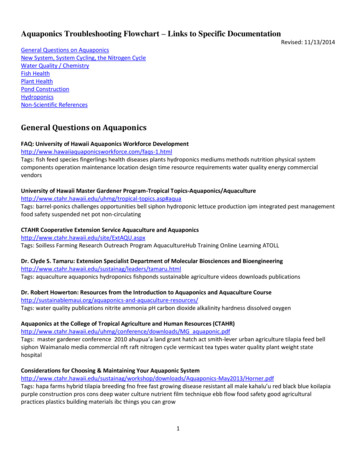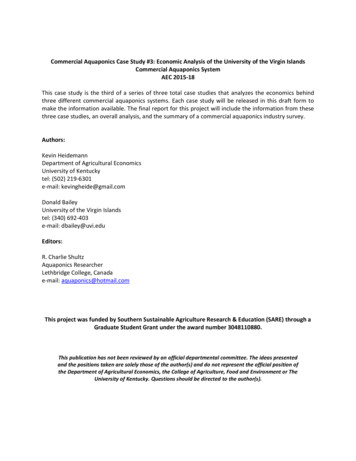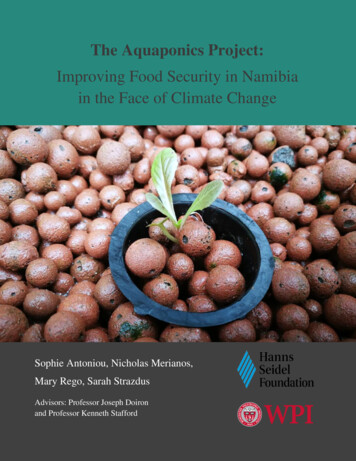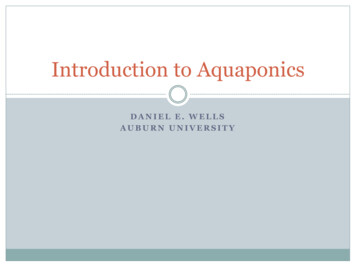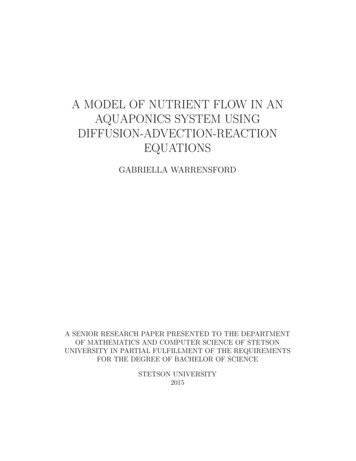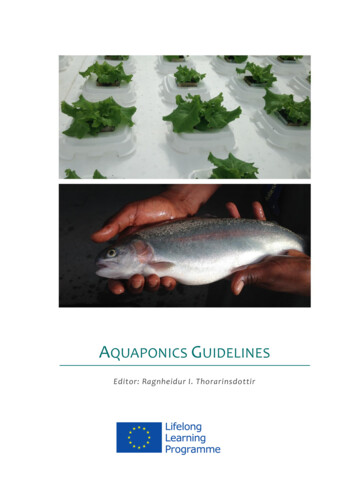
Transcription
AQUAPONICS GUIDELINESEditor: Ragnheidur I. Thorarinsdottir
AQUAPONICS GUIDELINESEditor: Ragnheidur I. Thorarinsdottir
Aquaponics GuidelinesAugust 2015ISBN: 978-9935-9283-1-3Printed by Haskolaprent, Reykjavik, IcelandLayout: Anna Maria ProppeContributors:Dr. Ragnheidur Thorarinsdottir, Svinna-verkfraedi Ltd, www.svinna.is and University of IcelandDr. Paul Rye Kledal, IGFF, Denmark, www.igff.dkSiv Lene Gangenes Skar, Nibio, Norway, www.nibio.noFernando Sustaeta, Breen, Spain, www.breen.esDr. Kristin Vala Ragnarsdottir, University of Iceland, www.hi.is, earthice.isDr. Utra Mankasingh, www.hi.isDr. Edoardo Pantanella, Eureka, Italy, www.eurekafarming.comRob van de Ven, LandIng Aquaculture, Netherlands, www.landingaquaculture.comR. Charlie Shultz, Texas, USA, www.globalaquaponics.netSpecial thanks to:Dr. Ranka Junge, ZHAW, Switzerland, www.zhaw.ch, Dr. Vesna Milicic, Ponikawww.ponnod.com and University of Ljubljana, Slovenia, www.uni-lj.si and Dr. Harry Palm,University Rostock, Germany, www.uni-rostock.de for providing information and pictures fromtheir aquaponic systems.
SummaryAquaponics is a combination of the words aquaculture (cultivating fish) andhydroponics (growing plants in water without soil) and the eco-innovativetechnology behind the concept is a combination of the two production systems intoone. It is driven by a microbial ecosystem that assists in converting fish effluents intousable plant nutrients while helping deliver plant nutrients across root cell walls. Inan aquaponic system, water is kept in circulation. Waste water from the fish is usedas nutrients in the horticultural part of the system where plants take up the nutrientsprovided by the fish waste and cleanse the water before being returned to the fish.Aquaponics is a resource efficient closed loop food production system, mimickingnature itself. This relates to cradle-to-cradle design presenting eco-effectivenessmoving beyond zero emissions and produce services and products taking intoaccount social, economic and environmental benefits (McDonough and Braungart,2002; Braungart et al., 2007; Kumar and Putnam, 2008).Small private and/or educational/research aquaponic systems have been built inseveral places around the world and the technology is becoming increasinglypopular. There is rising interest for industrial show cases, to test whether it can be aprofitable business to run large-scale aquaponic systems, raising fish and plantssimultaneously for the market. Commercial-scale facilities, although limited innumber, can now be found across the globe that incorporate modern technologybased on automatic control, improved system balance and health and safety.The conditions to implement an aquaponics industry in Europe are currently beingevaluated and several pilot units of different sizes and design have been constructedin most European countries. Only very few of them reach a production area of morethan a few square meters (m2). However, systems are now planned or have beenbuilt on a medium scale of a few hundreds and up to a few thousand m2.These guidelines present a short history of aquaponics as well as the current status ofaquaponics development in Europe. The main types of aquaponics system design areoutlined along with guidelines for how the environmental parameters need to becontrolled. Moreover, in this guiding document the production parameters aredescribed, including suitable choices of plants and fish species. The marketconditions, certification and regulatory issues are discussed, also including addedvalue opportunities linked to experience and educational tourism, technologydevelopment and byproducts, e.g. from sludge processing. Finally, conclusions andfuture perspectives are put forward.It is the hope of the authors that the guidelines can be of value to aquaponicshobbyists as well as others who plan to develop commercial scale aquaponics. Theguidelines are built on collaborative work between two European projects: theLeonardo project EuroPonics (www.aquaponics.is/europonics) that focuses on
vocational training in aquaponics and the EASME project EcoPonics(www.aquaponics.is/ecoponics/) which aims to establish commercial aquaponics inEurope. Further contributors are aquaponics specialists from the managementcommittee of the COST Action FA1305 The EU Aquaponics Hub – RealisingSustainable Integrated Fish and Vegetable Production for the EU(www.euaquaponicshub.com/).Keywords: Aquaponics, aquaculture, hydroponics, zero-waste, renewable energy,tourism
ContentsSummary . 5List of figures . 9Acknowledgements . 101Introduction – What is aquaponics?. 92History of aquaponics . 122.1University of Virgin Islands (UVI) . 122.2Developing units in Europe .142.3Decoupled systems . 213System description . 223.1Recirculating aquaculture system (RAS) . 223.2Mechanical filtration . 223.3Biofiltration . 263.4Hydroponics . 2943.4.1Grow beds . 313.4.2Nutrient film technique (NFT) . 313.4.3Raft / deep water culture (DWC) . 32System control and optimization . 334.1Controlling environmental parameters . 334.2Temperature . 344.3Dissolved oxygen . 344.4Chemical oxygen demand and biochemical oxygen demand . 354.5pH . 354.6Alkalinity . 364.7Nitrogen compounds . 374.8Electrical conductivity . 384.9Macro- and micronutrients . 395Production management . 425.1Choices of species – fish . 435.2Choices of species – plants . 455.3Quality and production of edible plants . 47
5.4Societal factors . 495.5Risk analysis . 496Market and certifications . 516.1Organic certification . 526.1.1Horticultural produce . 526.1.2Aquacultural produce . 526.1.3Future of organic aquaponics . 537Added value . 558Conclusion and future perspectives . 57References . 58
List of figuresFigure 1.1 Aquaponic system . 9Figure 1.2 Decoupled aquaponic system . 10Figure 2.1 UVI aquaponic system diagram (Rakocy et al., 1997) . 13Figure 2.2 Breen aquaponics pilot unit in Hondarribia, Spain .14Figure 2.3 Hatching facilities at Tknika .14Figure 2.4 New 6,000 m2 commercial aquaponics farm under construction . 15Figure 2.5 IGFF aquaponics pilot unit . 15Figure 2.6 Schematic diagram of the IGFF aquaponics pilot unit . 16Figure 2.7 Bio-filter, UV-lighting, sedimentation tanks and airblower . 16Figure 2.8 Svinna aquaponics pilot unit in Laugaras, Iceland . 17Figure 2.9 Nibio aquaponics pilot unit in Grimstad, Norway . 18Figure 2.10 Ponika aquaponics pilot unit in Prekmurje, Slovenia . 18Figure 2.11 Eureka farm R&D unit near Rome, Italy . 19Figure 2.12 FishGlassHouse . 19Figure 2.13 Decoupled system at IGFF . 21Figure 3.1 Schematic overview of a recirculating aquaculture system (RAS) . 22Figure 3.2 Sedimentation tank (left) and drum filter (right) . 24Figure 3.3 Bead filter, trickling filter, moving bed bioreactor and swirl separator . 29Figure 3.4 From left: Media bed, nutrient film and floating raft aquaponics . 30Figure 3.5 Grow-beds at Breen . 31Figure 3.6 Nutrient film technique with okra plants . 31Figure 3.7 Floating system / deep water culture (DWC) . 32Figure 4.1 Schematic representation of the N cycle in aquatic system . 38Figure 4.2 Potassium deficiency in a tomato plant . 40Figure 4.3 Calcium deficiency affecting tomato production . 40Figure 4.4 Iron deficiency in an okra plant .41Figure 5.1 Nile Tilapia . 43Figure 5.2 Lettuce (Lactuca sativa) produced at Nibio in Grimstad . 45Figure 5.3 Okra and pak-choi produced by Svinna in Reykjavik . 45Figure 5.4 Annual production kg per square meter of leafy greens in aquaponics(Savidov, 2010) . 46Figure 5.5 Root rot from phytium (left) vs healthy roots (right) . 48Figure 7.1 Red claw crayfish (Cherax quadricarinatus) from Svinna s pilot unit . 55Figure 7.2 Worm cultivation at Breen . 55
AcknowledgementsSpecial thanks are given to the following persons for supplying photos, schematicpictures and good advice.Ragnar Ingi Danner:2.8, 7.1Marvin Ingi Einarsson:1.1, 1.2, 2.8, 3.1Siv Lene Gangenes Skar:2.9, 3.5, 5.2Dr. Paul Rye Kledal:2.5, 2.6, 2.7, 2.13Ulrich Ricardo Knaus:2.12Soffia K Magnusdottir:5.1Dr. Vesna Milicic:2.10Dr. Olafur P Palsson:2.4, 3.2, 3.3, 3.4, 3.6, 4.2, 4.4, 5.3Dr. Edoardo Pantanella:2.11R. Charlie Shultz:3.7, 5.5Fernando Sustaeta:2.2, 2.3, 3.4, 4.3, 7.2
Aquaponics Guidelines1Page 9Introduction – What is aquaponics?Aquaponics is a food production method for producing terrestrial plants and aquaticorganisms that combines two traditional production systems – recirculatingaquaculture and hydroponics. Aquaponic systems recirculate and recycle all thewater and nutrients through symbiotic processes preventing discharge of eutrophicor organic wastes. In November 2010, The Aquaponics Gardening Community1 putforward the following definition:Aquaponics is the cultivation of fish and plants together in a constructed,recirculating ecosystem utilizing natural bacterial cycles to convert fishwaste to plant nutrition. This is an environmentally friendly, natural foodgrowing method that harnesses the best attributes of aquaculture andhydroponics without the need to discard any water or filtrate or addchemical fertilizers.Aquaponics is an ecosystem of plants, fish, bacteria, sometimes worms and/or otherorganisms, growing together symbiotically (Figure 1.1). The beneficial bacteriaconvert the waste water from the fish into plant food, and the plants filter the wastewater for nutrients before the water returns back to the fish.Figure 1.1 Aquaponic systemMany of today’s aquaponic systems circulate water and nutrients from fish to plantsto fish as shown in Figure 1.1 and the water quality is specifically managed to fit therequirements of the fish species being cultured and suitable plants are chosen to fit1http://community.theaquaponicsource.com/
Page 10Introduction – What is aquaponics?the fish environment. It is not always guaranteed that the fish preferences arecompletely aligned with the optimum requirements of the plants. This calls forcompromising of the plant’s needs, and as a result they may not achieve their fullgrowth capacity. Therefore another design has been investigated in which the waterflow is divided into two independent systems that can occasionally communicatewhenever plants need a boost in nutrients or fish require reclaimed water fromplants to dilute the wastes accumulating in the fish sub-unit. This solution, which isreferred to as a “decoupled” system (Figure 1.2) would better secure optimalenvironmental conditions for both the plant and fish production units and maybecome a cornerstone towards the implementation of large commercial aquaponicsystems. The risk mitigation factor alone has increased the use of decoupled systemsglobally. If a problem occurs in the fish or the plant components, each section can beisolated and run as a stand-alone aquaculture or hydroponic system, while theproblem is addressed.Figure 1.2 Decoupled aquaponic system
Aquaponics GuidelinesPage 11Many options exist for solid waste management in aquaponic systems. Dischargedsolid wastes may be utilized to create value added products such as compost or onfarm seeding media (Danaher et al., 2011; Pantanella et al., 2011a). Solids can also bemineralized in a separate loop, allowing dissolved nutrients to be returned to thesystem. Rakocy et al. (2005) described mineralization rates of discharged effluentsfrom an aquaponic system operated in the US Virgin Islands. Several ideas are beingtested aiming for zero-waste solutions, using the sludge as e.g. feed for crayfish,farming of worms and/or black soldier flies, or making fertilizer or biogas throughaerobic or anaerobic digestion.
Page 122History of aquaponicsHistory of aquaponicsAquaponic systems have been developing and the interest in the field has beenincreasing, not least due to the pressure to produce more food in a sustainablemanner for a rapidly increasing world population (Goddek et al., 2015; Mageau et al.,2015). Increasing energy costs and dwindling natural resources such as phosphorousand water (Sverdrup and Ragnarsdottir, 2014) are forcing the world to take actionand change present-day food production systems. Scientists and innovationcompanies have started national and international collaboration projects fordevelopment and future possibilities of local and sustainable food production.Innovations include aquaponics, production of insects and other products - whatpreviously would have been thought of as far flung ideas.One of the main challenges regarding aquaponics and other integrated productiontechniques is to join two or more different production systems together. Aquacultureand horticulture are quite different production technologies and joining them into asimple aquaponics circulation may result in a stable production system with optimumoutput. However, it has hitherto proved to be difficult to join skills, knowledge andtraditions from different production cultures.Aquaponics in the modern era began in areas that are limited in fresh water,particularly Australia and other arid regions such as the US Virgin Islands. With limitedfresh water resources and an increasing demand for food to supply a growingpopulation, these regions began to link fish and plant culture together in anintegrated system. While the Australian movement initially focused on small-scalefood production, the University of the Virgin Island began to trial commercial levelsof production in an attempt to create a viable industry.2.1University of Virgin Islands (UVI)The pioneers in aquaponics include scientists at the Universityof Virgin Islands (UVI), led by Dr. Jim Rakocy who beganaquaponics research in the late 1970 s. This system has beenthe inspiring layout of several commercial systems in the USand systems built by several growers and researchersworldwide. The University of Virgin Islands has been active inaquaponics research for more than thirty years and has aglobally recognized aquaponics education program. The system developed at UVI is araft hydroponic system and the aquaculture part focus is on tilapia production(Rakocy, 1989; Rakocy and Hargreaves, 1993; Rakocy, 1997; Rakocy et al., 1997;Rakocy et al., 2003; Rakocy et al., 2004a; Rakocy et al., 2006a; Rakocy et al., 2006b;Rakocy et al., 2007; Rakocy et al., 2012).
Aquaponics GuidelinesPage 13Figure 2.1 UVI aquaponic system diagram (Rakocy et al., 1997)A continuous operation was run at UVI for 2.5 years (1995-1997) with red tilapia andleaf lettuce production (Rakocy et al., 1997; Rakocy et al., 2007). The system (Figure2.1) staggered fish production using four fish rearing tanks, each with 7.8 m3 watervolume (total 31.2 m3), two cylindro-conical clarifiers (3.8 m3 each), four rectangularfilter tanks (0.7 m3 each) containing orchard netting, six hydroponic tanks (11.5 m 3each) and a sump (0.6 m3). The hydroponic tanks were 30.5 m long by 1.2 m wide by0.4 m deep and had a combined surface area of 214 m 2. Thus, the surface area to fishtank volume was 6.85 m2/m3. The water volume was 110 m3. A 0.5 hp in-line pumpmoved water at an average rate of 378 L/min from the sump to the fish rearing tanks(mean retention time of water 1.5 h), from which effluent flowed with gravitythrough the system. Air diffusers were used both in fish and hydroponic tanksthrough airstones supplied by air from a 1.5 hp blower for fish and 1 hp blower forplants.The daily fish feed input averaged 12 kg equivalent to 56 g/m2 plant growing area. Thewaste water from the fish was only supplemented with potassium (K), calcium (Ca)and iron (Fe) to provide sufficient amounts of the essential nutrients for normal plantgrowth. Potassium and calcium were supplied as hydroxides, also serving to raise thepH while supplementing these nutrients. These additions were equivalent to 16.1 gKOH, 3.3 g CaO, 13.7 g Ca(OH)2 (more economical than CaO) and 6.0 g iron chelate(10%) per kg of fish feed. The annual production of tilapia was 3,096 kg and thelettuce production was projected to 1,694 cases (appr. 11 tons), or appr. 3.5 tonslettuce per ton tilapia produced and the land use was 0.04 ha, which can beconsidered being a small to medium scale system.
Page 142.2History of aquaponicsDeveloping units in EuropeAquaponic systems are being developed in several places in most if not all Europeancountries. Most of the systems are small hobby or research units. In recent years afew semi-commercial pilot units have been put to the test and these systems provideexcellent information for the future developments.The SME Breen2 in Hondarribia, Spain has developed asystem of 500 m2 during the last five years (Figure 2.2) and isexpanding to a two thousand square meter productionsystem (Figure 2.3) in Renteria at Tknika3, the Centre forInvestigation and Applied Innovation in VET (VocationalEducation and Training). The installations at Tknika will serveas the main hatchery of tilapia for production installations, asresearch laboratory and as a national and international training facilities inaquaponics.Figure 2.2 Breen aquaponics pilot unit in Hondarribia, SpainBreen s systems have always been run with tilapia production and many differentplants have been tested in the systems, including salads, a variety of herbs,tomatoes, peppers and oranges. The aquaponics development at Breen started in2010 and the company has made several test units built on grow-bed, raft andnutrient film technique (NFT) - see further description of the different systems inSection 3.4 below.Figure 2.3 Hatching facilities at Tknika2www.breen.eswww.tknika.eus3
Aquaponics GuidelinesPage 15Figure 2.4 New 6,000 m2 commercial aquaponics farm under constructionBreen has associated with an investor group called NER. This alliance is constructing anew aquaponics production unit of 6,000 m2 to produce up to 125 tons of tilapia, 15tons of tomatoes, 6 tons of strawberries and up to 50,000 salads per year. Theinstallation is situated close to the pilot unit in Hondarribia and is planned to startoperation mid 2016 and be in full production a year later. Photos from theconstruction site are shown in Figure 2.4.Institute of Global Food and Farming (IGFF) 4 in Denmark hasdeveloped a decoupled aquaponics unit of 60 m2 (Figure 2.5).The IGFF unit consists of six plant tables arranged in threepairs of 1.45 x 7.50 m on the top of three rectangular fishtanks (3 x 1 x 0.8 m) with a usable volume of 2 m3 each. Planttables produce horticulture products in pots with soil andcompost to open up for the prospect of getting an organiccertification for the aquaponic system. Soil is used because to obtain an organiccertification requires plants to be grown in various specified types of soil. SilverFigure 2.5 IGFF aquaponics pilot unit4www.igff.dk
Page 16History of aquaponicstilapia, red tilapia and pike perch have been tested as fish species and various plantssuch as lettuce, basil, tomatoes and peppers have been grown successfully on theplant tables.Figure 2.6 shows a schematic drawing of the system. Water to the plants is suppliedby the “ebb and flow” principle. To secure as much as possible plant growing area inthe greenhouse cube, the bio-filter, UV-lighting, air pumps, pH regulation and sedimentation tanks are placed outside the cube (Figure 2.7). The oxygen supply to thefish tanks is secured by three independent air blowers. The tanks are connected to acentral water discharge line that ends in two sedimentation chambers. Thesechambers do not only serve as pre-filtration systems but also as pump sumps. Eachchamber is connected to one separate lift pump, providing a pumping capacity ofaround 15m3/h. The total water flow is split into two independent loops. In one ofthem, the fish loop, the pumps supply water to a bead filter that acts as a mechanicalas well as a biological filter. This loop has in-line ultraviolet disinfection system (UVsystem). From the UV system the water can be led to the plant tables and/or directlyback to the fish tanks located beneath the plant tables. The water from the planttables can also enter the fish tanks by gravity or can directly be discharged into themain discharge line and the sedimentation chambers.In the second loop (plant loop) the lift pump supplies the water directly back to theplant tables from where it enters the fish tanks. Both lift pumps are frequencyregulated, and the plant loop pump is equipped with a timer that allows to pre-setpumping time and -duration to follow a “ebb and flow” watering schedule of theplant tables (Kledal, 2012).Figure 2.6 Schematic diagram of the IGFFaquaponics pilot unitFigure2.7Bio-filter,UV-lighting,sedimentation tanks and airblower
Aquaponics GuidelinesPage 17The Icelandic company Svinna-verkfraedi Ltd5 has incollaboration with the University of Iceland implemented aRAS system with tilapia in the greenhouses of Akur, an organicgreenhouse horticulture farm in South Iceland. The RASsystem is connected to an NFT system with okra, tomatoes,beans and lettuce. The fish waste water nutrient solution isalso used for irregation of the organic soil production. Theaquaponic system consists of three 4 m3 fish tanks, a drumfilter, a biofilter, a sumptank and NFT pipes for larger plants, see Figure 2.8.Svinna has developed aquaponic systems since 2013 and has run tests with growbeds, raft and NFT with several other plant types. The setup today is partly decoupledas part of the water is used for soil irrigation and the plan is to move more in thatdirection to secure optimum conditions for both fish and plants. The company is nowadding crayfish to the system to make use of the sludge from the fish tanks.Furthermore, a worm bed is used for plant waste. Thus, zero-waste is obtained in thesystem. The company aims to link educational and experience tourism to theproduction showing the water and nutrient cycles, how waste from one productionunit is turned into value for the next one and how sustainable geothermal energy isused for the production. The future ideas also include a restaurant serving theproducts from the system. Moreover, further research is planned for futuredevelopment and expansion of production.Figure 2.8 Svinna aquaponics pilot unit in Laugaras, Iceland5www.svinna.is
Page 18History of aquaponicsNibio6 (former Bioforsk) in Grimstad South Norway has since2010 been involved in aquaponics development (Skar, 2010).The institute developed and implemented a test system in2013, based on cold water fish and has tested brown trout andrainbow trout in the RAS system together with saladproduction in a raft system, see Figure 2.9. The system hasbeen running stable with a weekly production of salad. Thesystem at Nibio includes four 1 m3 fish tanks and two 15 m2 raft basins. Mechanicalfiltration is performed at each tank and through a bead filter which also serves asbiofilter. Furthermore, a trickling filter provides additional biofiltration and aeration.Figure 2.9 Nibio aquaponics pilot unit in Grimstad, NorwayThe SME Ponika7 in Slovenia has built a 400 m2 commercialaquaponic system recently starting up production. The systemis situated in the heart of the Landscape Park Goričko andNatura 2000 site. The RAS system has largemouth bass and theplants grown are chives, peppermint, basil and lemon grass in495 rafts, see Figure 2.10.Figure 2.10 Ponika aquaponics pilot unit in Prekmurje, Slovenia67www.nibio.nowww.ponnod.com
Aquaponics GuidelinesPage 19Eureka Farming8 in Italy has developed a 500 m2 experimentalarea under two greenhouses and outdoor space supplied withfloating systems, substrate aquaponics and dynamic rootfloating technique (Figure 2.11). The company has successfullyfarmed both freshwater (nile tilapia, largemouth bass, Africancatfish) and saline fish species (grey mullet, Europeanseabass). Beside the biological production and the quantiqualitative improvement of the productions from traditional horticulture, the focusof Eureka is to develop new aquaponics solutions for the industry that allow theexpansion of aquaponics with both staples and saline crops. Eureka has beencommitted in bringing aquaponics and integrated systems in arid lands, in designingand running micro systems in South East Asia for food security and to carry out R&Dfor the integration of the tilapia nursery industry with aquaponics.Figure 2.11 Eureka farm R&D unit near Rome, ItalyThe FishGlassHouse was built at the campus site of theFaculty of Agricultural and Environmental Sciences (AUF),University of Rostock in Germany. The fully closed intervalcontrolled aquaponic system consists of three aquacultureunits (300 m²) and six cabins for plant cultivation underhydroponic conditions (600 m²). The fish production ofAfrican catfish (Clarias gariepinus) is carried out by usingjuveniles from a local fish producer (PAL AnlagenbauGmbH, Abtshagen). Different plants like herbs andvegetables are produced within the different hydroponicsubsystems. Experiments are carried out under floatingraft, “ebb and flow”, nutrient flow technique (NFT) orplanting table conditions in cooperation with a local plantproducer, Grönfingers GmbH (Rostock).8ww
Aquaponic systems recirculate and recycle all the water and nutrients through symbiotic processes preventing discharge of eutrophic or organic wastes. In November 2010, The Aquaponics Gardening Community1 put forward the following definition: Aquaponics is the cultivation of fish and plan
